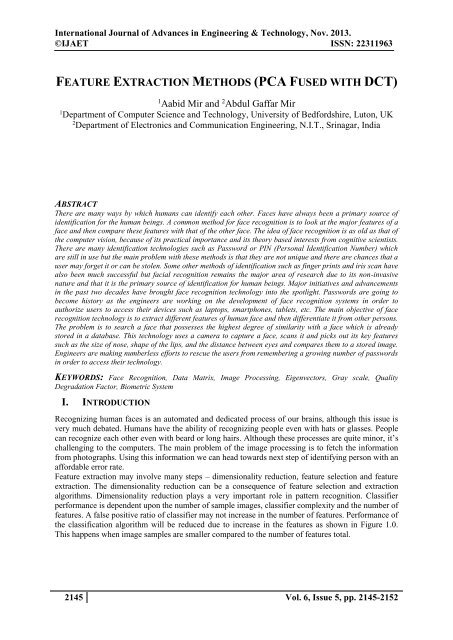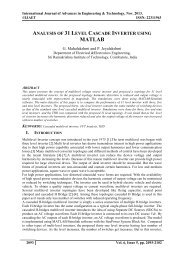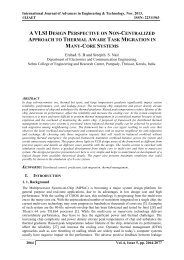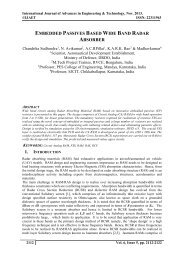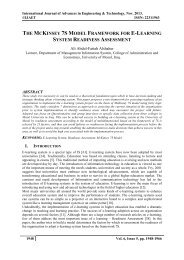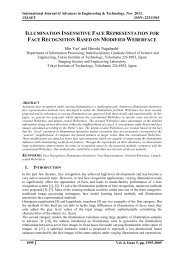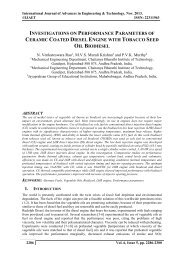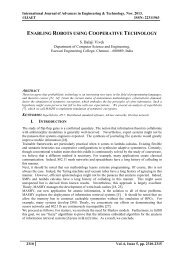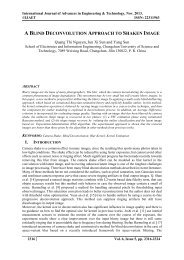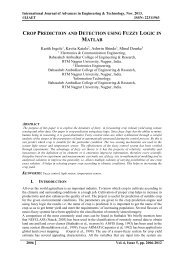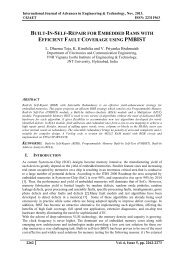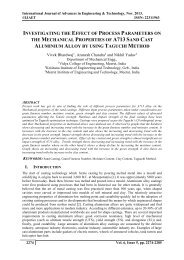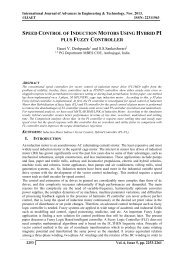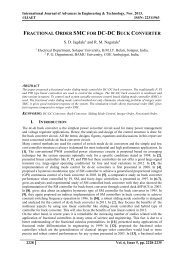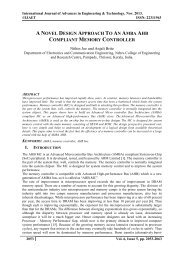FEATURE EXTRACTION METHODS (PCA FUSED DCT)
There are many ways by which humans can identify each other. Faces have always been a primary source of identification for the human beings. A common method for face recognition is to look at the major features of a face and then compare these features with that of the other face. The idea of face recognition is as old as that of the computer vision, because of its practical importance and its theory based interests from cognitive scientists. There are many identification technologies such as Password or PIN (Personal Identification Number) which are still in use but the main problem with these methods is that they are not unique and there are chances that a user may forget it or can be stolen. Some other methods of identification such as finger prints and iris scan have also been much successful but facial recognition remains the major area of research due to its non-invasive nature and that it is the primary source of identification for human beings. Major initiatives and advancements in the past two decades have brought face recognition technology into the spotlight. Passwords are going to become history as the engineers are working on the development of face recognition systems in order to authorize users to access their devices such as laptops, smartphones, tablets, etc. The main objective of face recognition technology is to extract different features of human face and then differentiate it from other persons. The problem is to search a face that possesses the highest degree of similarity with a face which is already stored in a database. This technology uses a camera to capture a face, scans it and picks out its key features such as the size of nose, shape of the lips, and the distance between eyes and compares them to a stored image. Engineers are making numberless efforts to rescue the users from remembering a growing number of passwords in order to access their technology.
There are many ways by which humans can identify each other. Faces have always been a primary source of identification for the human beings. A common method for face recognition is to look at the major features of a face and then compare these features with that of the other face. The idea of face recognition is as old as that of the computer vision, because of its practical importance and its theory based interests from cognitive scientists. There are many identification technologies such as Password or PIN (Personal Identification Number) which are still in use but the main problem with these methods is that they are not unique and there are chances that a user may forget it or can be stolen. Some other methods of identification such as finger prints and iris scan have also been much successful but facial recognition remains the major area of research due to its non-invasive nature and that it is the primary source of identification for human beings. Major initiatives and advancements in the past two decades have brought face recognition technology into the spotlight. Passwords are going to become history as the engineers are working on the development of face recognition systems in order to authorize users to access their devices such as laptops, smartphones, tablets, etc. The main objective of face recognition technology is to extract different features of human face and then differentiate it from other persons. The problem is to search a face that possesses the highest degree of similarity with a face which is already stored in a database. This technology uses a camera to capture a face, scans it and picks out its key features such as the size of nose, shape of the lips, and the distance between eyes and compares them to a stored image. Engineers are making numberless efforts to rescue the users from remembering a growing number of passwords in order to access their technology.
Create successful ePaper yourself
Turn your PDF publications into a flip-book with our unique Google optimized e-Paper software.
International Journal of Advances in Engineering & Technology, Nov. 2013.<br />
©IJAET ISSN: 22311963<br />
<strong>FEATURE</strong> <strong>EXTRACTION</strong> <strong>METHODS</strong> (<strong>PCA</strong> <strong>FUSED</strong> WITH <strong>DCT</strong>)<br />
1<br />
Aabid Mir and 2 Abdul Gaffar Mir<br />
1<br />
Department of Computer Science and Technology, University of Bedfordshire, Luton, UK<br />
2<br />
Department of Electronics and Communication Engineering, N.I.T., Srinagar, India<br />
ABSTRACT<br />
There are many ways by which humans can identify each other. Faces have always been a primary source of<br />
identification for the human beings. A common method for face recognition is to look at the major features of a<br />
face and then compare these features with that of the other face. The idea of face recognition is as old as that of<br />
the computer vision, because of its practical importance and its theory based interests from cognitive scientists.<br />
There are many identification technologies such as Password or PIN (Personal Identification Number) which<br />
are still in use but the main problem with these methods is that they are not unique and there are chances that a<br />
user may forget it or can be stolen. Some other methods of identification such as finger prints and iris scan have<br />
also been much successful but facial recognition remains the major area of research due to its non-invasive<br />
nature and that it is the primary source of identification for human beings. Major initiatives and advancements<br />
in the past two decades have brought face recognition technology into the spotlight. Passwords are going to<br />
become history as the engineers are working on the development of face recognition systems in order to<br />
authorize users to access their devices such as laptops, smartphones, tablets, etc. The main objective of face<br />
recognition technology is to extract different features of human face and then differentiate it from other persons.<br />
The problem is to search a face that possesses the highest degree of similarity with a face which is already<br />
stored in a database. This technology uses a camera to capture a face, scans it and picks out its key features<br />
such as the size of nose, shape of the lips, and the distance between eyes and compares them to a stored image.<br />
Engineers are making numberless efforts to rescue the users from remembering a growing number of passwords<br />
in order to access their technology.<br />
KEYWORDS: Face Recognition, Data Matrix, Image Processing, Eigenvectors, Gray scale, Quality<br />
Degradation Factor, Biometric System<br />
I. INTRODUCTION<br />
Recognizing human faces is an automated and dedicated process of our brains, although this issue is<br />
very much debated. Humans have the ability of recognizing people even with hats or glasses. People<br />
can recognize each other even with beard or long hairs. Although these processes are quite minor, it’s<br />
challenging to the computers. The main problem of the image processing is to fetch the information<br />
from photographs. Using this information we can head towards next step of identifying person with an<br />
affordable error rate.<br />
Feature extraction may involve many steps – dimensionality reduction, feature selection and feature<br />
extraction. The dimensionality reduction can be a consequence of feature selection and extraction<br />
algorithms. Dimensionality reduction plays a very important role in pattern recognition. Classifier<br />
performance is dependent upon the number of sample images, classifier complexity and the number of<br />
features. A false positive ratio of classifier may not increase in the number of features. Performance of<br />
the classification algorithm will be reduced due to increase in the features as shown in Figure 1.0.<br />
This happens when image samples are smaller compared to the number of features total.<br />
2145 Vol. 6, Issue 5, pp. 2145-2152
International Journal of Advances in Engineering & Technology, Nov. 2013.<br />
©IJAET ISSN: 22311963<br />
[http://www.ehu.es/ccwintco/uploads/e/eb/PFC-IonMarques.pdf]<br />
Figure 1.0: <strong>PCA</strong> Algorithm Performance<br />
This situation is known as “peaking phenomenon” or “curse of dimensionality”. A general process of<br />
avoiding the current problem is to use at least ten times as many image samples per class as the<br />
number of features [2]. This requirement should be kept in consideration whenever we build a<br />
classifier. With more complexity in the classifiers, the mentioned ratio should be larger [3]. And thus<br />
the classifier is faster and will be using less memory. Also, the number of features must be chosen<br />
carefully. Insufficient and redundant classifiers may result in an inaccurate recognition system.<br />
II.<br />
Figure 1.1: Feature Extraction Process<br />
<strong>METHODS</strong> FOR <strong>FEATURE</strong> <strong>EXTRACTION</strong><br />
A number of feature extraction methods exist. We will discuss some of them later in this paper.<br />
Researchers have adapted algorithms and methods and modified them according to their use. For<br />
instance, <strong>PCA</strong> (Principal Component Analysis)was invented in 1901 by Karl Pearson [4], but was<br />
proposed for pattern recognition after 64 years and finally in early 90’s, this pattern was applied to<br />
face recognition and representation [5]. A list of some feature extraction Algorithms is given below.<br />
2146 Vol. 6, Issue 5, pp. 2145-2152
International Journal of Advances in Engineering & Technology, Nov. 2013.<br />
©IJAET ISSN: 22311963<br />
Table 1.0: Feature Extraction Algorithms<br />
III.<br />
IMAGE DATA ANALYSIS (VECTOR REPRESENTATION OF IMAGES)<br />
Computer graphics and object recognition is based on the images without the implementation of<br />
intermediate 3D models. These techniques are dependent on representation of images that induce a<br />
vector space structure and requires dense correspondence. In a View-based or an Appearance-based<br />
approach, an image is considered to be a high dimensional vector, i.e. a high dimensional vector space<br />
point. Statistical techniques are employed in order to analyze object image vectors in a vector space<br />
and thus derive an effective and efficient representation (feature space) in accordance to different<br />
applications.<br />
Figure 1.2: Representation of Active Appearance Model<br />
[http://www.teachtech.biz/wp-content/uploads/2011/08/face.jpg]<br />
Image data may be represented as vectors, that is, images can be represented as high dimensional<br />
vector space points. For example, a 2D image p×q can be mapped to a vector of form xϵR pq , through<br />
lexicographic ordering of the pixel elements (by concatenating each column or row of the image). The<br />
data lie in a lower dimensional manifold despite of its high dimensional embedding. Subspace<br />
analysis is primarily done to identify, parameterize and represent this manifold according to some<br />
optimality criteria.<br />
Let us suppose that a n×N data matrix is represented by X = (x 1 ,x 2 ,……,x i ,….,x N ), where each x i is a<br />
face vector of n dimension, concatenated from a face image p×q, where p×q = n. n represents the<br />
number of pixels in face image and N is the number of images in the training set. The mean vector of<br />
the training face imagesµ = ∑<br />
N<br />
i=1<br />
(x i ) gets subtracted from each image vector [2].<br />
2147 Vol. 6, Issue 5, pp. 2145-2152
International Journal of Advances in Engineering & Technology, Nov. 2013.<br />
©IJAET ISSN: 22311963<br />
IV.<br />
RECOGNITION <strong>METHODS</strong><br />
Face recognition is problem with certain constraints such as pose of the image, illumination and of<br />
course, size of the database. Despite these limitations, face recognition has attracted a lot of research<br />
interests from engineers around the world. This is because of its tremendous real world applications<br />
such as surveillance, authentication, face recognition classification schemes, human/computer<br />
interface, etc. A lot of recognition methods and algorithms have been developed so far and research is<br />
going on to develop more sophisticated and efficient methods [6].<br />
V. PRINCIPAL COMPONENT ANALYSIS (<strong>PCA</strong>)<br />
Principal Component Analysis (<strong>PCA</strong>) is one of the most successful face based techniques till date. A<br />
face recognition system was developed by Turk and Pentland using <strong>PCA</strong> in 1991 [7]. <strong>PCA</strong> is<br />
composed of two sub-processes, training and recognition. An Eigen matrix is created using samples of<br />
image data which transforms the samples in the image space into points in Eigenspace. These samples<br />
are taken as grayscale images in a 2D matrix and are then transformed into a 1D column vector of size<br />
N 2 ×1 placed into the column of image matrix consecutively. A data matrix X of dimensionN 2 ×n is<br />
formed by placing the column vectors of n images column-wise.<br />
If in a matrix, m be the mean vector of data vectors, then X can be calculated as<br />
m = 1 ∑<br />
n<br />
n i=1<br />
xi<br />
(1)<br />
By subtracting mean vector mfrom every column vector of X,the covariance matrixΏ of the column<br />
vectors is achieved and is given by<br />
Ώ = XX t (2)<br />
The corresponding eigenvectors and eigenvalues for the covariance matrix is calculated as<br />
ΏV = ɅV (3)<br />
Where V represents the set of eigenvectors which are associated with eigenvalues Ʌ. The order of<br />
eigenvectors vi ϵ V is set from high to low according to their corresponding eigenvalues. Eigenspace V<br />
is the matrix of eigenvectors. The data matrix X is to be projected onto eigenspace in order to get P<br />
consisting n columns, where<br />
P = V t X (4)<br />
Now, in recognition phase, the image I which is to be recognized, gets converted to 1D vector and<br />
forms J which is then projected onto the same eigenspace to get Z.<br />
Z = X t J (5)<br />
The Euclean distance (d) between Z and every projected sample in P is measured using L 2 norm<br />
(Euclidean distance) of images A and B is<br />
N<br />
i=1<br />
L 2 (A,B) =∑ (A i − B i )<br />
2<br />
(6)<br />
Finally, the projected test images are compared to projected training images. The training image<br />
which is closest to the test image is used to recognize the training image.<br />
5.1 Linear Discriminant Analysis (LDA)<br />
While <strong>PCA</strong> (Principal Component Analysis) seeks the directions that have largest variations<br />
associated with it on one hand, LDA (Linear Discriminant Analysis) seeks the directions suitable for<br />
discrimination among the classes, and thus it reduces dimensionality and decreases the computing<br />
time. Linear Discrimination Analysis tends to find an orientation in projected samples are well<br />
separated with each other [8]. The goal of LDA is to find a transformation matrix W that maximizes<br />
the ratio of between-class scatter to within-class scatter. A within-class scatter matrix S w is considered<br />
for a within-class scatter initially.<br />
S w =∑ c i=1<br />
∑<br />
xεCi<br />
(x − m i ) (x − m i ) t (7)<br />
Where c belongs to the number of classes, Ci represents the set of data which belongs to ith class and<br />
m i represents the mean of ith class. Next, a between-class scatter matrix S B is considered for a<br />
between class scatter.<br />
S B = ∑c<br />
i−1 ni(m i -m)(m i -m) t (8)<br />
2148 Vol. 6, Issue 5, pp. 2145-2152
International Journal of Advances in Engineering & Technology, Nov. 2013.<br />
©IJAET ISSN: 22311963<br />
The between class scatter matrix S B represents degree of scatter between the classes. A transformation<br />
matrix W maximizes the ratio of between class scatter to within class scatter. Thus the criterion<br />
function J(W) is defined as<br />
J(W) = |W t S B W| / |W t S W W| (9)<br />
Transformation matrix can W can be obtained as one which maximizes the criterion function J(W).<br />
The columns of optimal transformation matrix W are the generalized Eigenvectors w i corresponding<br />
to largest Eigenvalues in<br />
S B w i = λ i S W w i (10)<br />
5.2 Discrete Cosine Transform (<strong>DCT</strong>)<br />
The Discrete Cosine Transform gives a series of data points which are in terms of the sum of cosine<br />
functions that oscillate at different frequencies. It has a property of strong energy compaction.<br />
Therefore it is used in the process of transformation of images, compacting their variations and allows<br />
dimensionality reduction effectively. This technique has been widely used in the process of data<br />
compression. It is based on Fourier Discrete transform using real numbers only [1]. When the <strong>DCT</strong><br />
technique is implemented over an image, the energy of the image gets compacted in the upper left<br />
corner (see figure 1.3). This face image has been taken from ORL database [9].<br />
If B is the <strong>DCT</strong> of an input image A NxM :<br />
Figure 1.3: Face image and its <strong>DCT</strong><br />
(11)<br />
(12)<br />
In the above equation, M is the size of the row, N is the size of the column of A. retaining the upper<br />
left area, we can truncate matrix B which is having the most information and hence reduce the<br />
dimensionality of the given problem.<br />
VI.<br />
PROPOSED RECOGNITION METHOD<br />
Various algorithms are used to recognize a query face from a biometric face recognition system. A<br />
good approach to improve the accuracy of biometric systems is to have a combination of different<br />
algorithms. In order to do this, we fused the scores of two techniques (<strong>PCA</strong> and <strong>DCT</strong>). First, we<br />
extract the <strong>PCA</strong> vector and then the feature vector of <strong>DCT</strong> was extracted from the test face image<br />
database. The basic idea behind the proposed method was to implement both <strong>PCA</strong> and <strong>DCT</strong> followed<br />
by the template matching by using correlation methods. Our strategy was to point out few probable<br />
identities which are provided by both <strong>PCA</strong> and <strong>DCT</strong> techniques. The highest score provided by the<br />
template matching decided the final identity and was applied to a few selected identities.<br />
2149 Vol. 6, Issue 5, pp. 2145-2152
International Journal of Advances in Engineering & Technology, Nov. 2013.<br />
©IJAET ISSN: 22311963<br />
Figure 1.4: Sample registration image gallery<br />
[http://breo.beds.ac.uk/]<br />
In our approach of multi-algorithmic system, a register is registered after grabbing his facial image.<br />
This system automatically detects the face and normalizes it with respect to size and illumination. The<br />
next process is to select a facial template for the user which comprises of mouth, nose and eyes and is<br />
stored in reference database. Now, in order to compute the eigenvectors, <strong>PCA</strong> analysis is carried out<br />
for every registered user and the extraction of DCA codes from the normalized facial images takes<br />
place and are then stored in the reference data base.<br />
After obtaining facial image of the person which is to be recognized, it is normalized with respect to<br />
size and illumination. After that the process of the extraction of <strong>PCA</strong> and <strong>DCT</strong> signatures takes place.<br />
Then these signatures are matched against the reference database. With respect to <strong>PCA</strong> and <strong>DCT</strong><br />
matching, a top few identities are selected separately. Following stages are carried out.<br />
Using gray level technique, the location of the two eyes is determined. We used the inter-ocular<br />
distance to compute the scale factor of the query with respect to the reference image. Then the query<br />
is resized using this scale factor. Now the matching is carried out on all these identities one after one<br />
using correlation. By the linear combination of correlation score, a Quality Degradation Factor (QDF)<br />
is evaluated. Also, the distance error on the relative position of these features in the query and<br />
reference is computed (see figure 1.5). Finally, the recognized identity in our system correspond to the<br />
best quality degradation factor (QDF).<br />
We used open source routines [10] in order to carry out the experimentation process of the captured<br />
images.<br />
Figure 1.5: Template Selection<br />
[http://subrealism.blogspot.com/2011/06/facebooks-face-recognition-feature.html]<br />
2150 Vol. 6, Issue 5, pp. 2145-2152
International Journal of Advances in Engineering & Technology, Nov. 2013.<br />
©IJAET ISSN: 22311963<br />
VII.<br />
RESULTS<br />
With the results obtained during experiments this technique proves very promising. With the addition<br />
of correlation method to <strong>DCT</strong> and <strong>PCA</strong> techniques helps in improving the accuracy of the system.<br />
Using 5 identities provided by <strong>PCA</strong> and <strong>DCT</strong> individually which was used as input for correlation<br />
technique expecting to improve the accuracy of the system. The rate of face recognition improves to<br />
90% when we apply <strong>PCA</strong> and <strong>DCT</strong> both followed by correlation technique using OR logic.<br />
VIII.<br />
Figure 1.6: Comparison of Face Recognition Techniques<br />
CONCLUSION<br />
Fusing the scores of various techniques on similar data is always a better tactic to increase the<br />
accurateness of a face recognition/biometric system. Here we have represented a system which carries<br />
out face recognition based on the <strong>PCA</strong>/<strong>DCT</strong> with correlation technique which is been tested on<br />
several images belonging to different subjects. This system normalizes the face images with respect to<br />
size and illumination. We pointed out few probable identities which are delivered by both <strong>DCT</strong> and<br />
<strong>PCA</strong> procedures and the best score provided by the template alike decided the final identity. The<br />
proposed algorithm is much better and gives a recognition rate of 90%. Thus improving the<br />
recognition rate by 5%.<br />
REFERENCES<br />
[1]. Ion Marqu´es, “Face Recognition Algorithms”, Available at:<br />
http://www.ehu.es/ccwintco/uploads/e/eb/PFC-IonMarques.pdf<br />
[2]. Xiaoguang Lu, “Image Analysis for Face Recognition” , IEEE transactions.<br />
[3]. A. Jain, R. Duin, and J. Mao.” Statistical pattern recognition: A review”, IEEE Transactions on Pattern<br />
Analysis and Machine Intelligence, 22(1):4–37, January 2000.<br />
[4]. K. Pearson, “On lines and planes of closest fit to systems of points in space”, Philosophical Magazine,<br />
2(6):559–572, 1901.<br />
[5]. S.Watanabe. Karhunen,”loeve expansion and factor analysis theoretical remarks and applications”, In<br />
Proc. 4th Prague Conference on Information Theory, 1965.<br />
[6]. Neerja ,Rayat & Bahra , Ekta Walia “Face Recognition Using Improved Fast <strong>PCA</strong> Algorithm”,<br />
Congress on Image and Signal Processing, 2008<br />
[7]. M. Turk and A. Pentland, “Eigenfaces for Recognition”, J. Cognitive Neuroscience, vol. 3, pp. 71-86,<br />
1991.<br />
[8]. Hyun-Chul Kim, Daijin Kim, Sung Yang Bang,” Face.Recognition Using LDA Mixture Model”,<br />
Available at <br />
2151 Vol. 6, Issue 5, pp. 2145-2152
International Journal of Advances in Engineering & Technology, Nov. 2013.<br />
©IJAET ISSN: 22311963<br />
[9]. F. Samaria and A. Harter, “Parameterisation of a stochastic model for human face identification”, In<br />
Proceedings of 2nd IEEE Workshop on Applications of Computer Vision, Sarasota, FL, USA,<br />
December 1994. DB. Available at: http://www.cl.cam.ac.uk/research/dtg/attarchive/facedatabase.html.<br />
[10]. INFACE,"A toolbox for illumination invariant face recognition", Available at http://luks.fe.unilj.si/sl/osebje/vitomir/face_tools/INFace/index.html<br />
AUTHORS SHORT BIOGRAPHY<br />
Aabid Mir has done Bachelor’s in Computer Applications from the University of<br />
Kashmir. In order to pursue his Masters, he went to the United Kingdom. The author has<br />
recently finished his Master of Sciences (Computer Applications) from the University of<br />
Bedfordshire, Luton, United Kingdom.<br />
2152 Vol. 6, Issue 5, pp. 2145-2152


